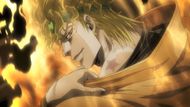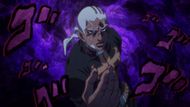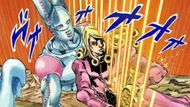JoJo's Bizarre Adventure isn’t just famous for its stylish action and outlandish characters, as each part’s villain also embodies a direct philosophical or thematic counterpoint to the story’s hero. From Part 3 through Part 8, the main antagonists not only stand in opposition to the protagonists but do so using Stands that represent the antithesis of the part’s core values. These aren’t just powers; rather, they’re thematic statements.
In this article, let us explore what each main villain's Stand truly represents in the context of their part of JoJo's Bizarre Adventure and their clash with the JoJo of that era.
The list of every main villain stand really represents JoJo's Bizarre Adventure
Dio Brando and The World

In JoJo's Bizarre Adventure: Stardust Crusaders, the narrative centers around reclaiming agency under pressure, using limited time and ability to solve increasingly dangerous puzzles. Jotaro’s Stand, Star Platinum, is all about precision, strength, and adaptability. DIO, on the other hand, is the ultimate abuser of advantages.
DIO is preserved by vampirism and has survived unaging, unbreathing, and is immune to time. He’s had over a century to reflect, plan, and build influence. And when he emerges with The World, it reflects his ultimate agency: the ability to stop time itself. While Jotaro has to earn his time stop through wit and growth, DIO is born into power through sheer unfair advantages.
His Stand symbolizes dominance over time, fate, and mortality. DIO doesn’t grow or evolve; he hoards and manipulates. He doesn’t need to become better when he can freeze the world and strike first.
Yoshikage Kira and Killer Queen

In JoJo's Bizarre Adventure: Diamond is Unbreakable, the theme shifts to community and the moral obligations of power in everyday society. Morioh is filled with Stand users, but Kira is a class apart. His desire isn’t power or glory, but rather it’s comfort. He wants to murder and live undisturbed.
Killer Queen symbolizes Kira’s pathological need for control and concealment. His right hand is a clean erasure: a landmine that removes people from existence. His left, Sheer Heart Attack, is automatic, cold, and relentless, symbolizing the mechanical way he eliminates threats. Bites the Dust, his third power, loops time to undo exposure, so he can live peacefully and continue killing.
Unlike Josuke, who channels his rage into protection and healing, Kira suppresses his humanity to remain hidden. His Stand represents the perverse ideal of a safe world, where Kira is never challenged, never seen, and his urges never questioned.
Diavolo and King Crimson

In JoJo's Bizarre Adventure: Vento Aureo, Giorno fights to bring dignity and opportunity to a society rotted by crime. His Stand, Gold Experience, grows into Gold Experience Requiem, symbolizing rebirth, undoing fate, and giving life.
Diavolo, however, uses King Crimson to dominate by obscuring cause and effect. He sees the future, skips time, and removes others’ agency to influence outcomes. Unlike Giorno in JoJo's Bizarre Adventure, who steps into risk to create better futures for others, Diavolo backsides his own life through Doppio and hides behind layers of deception.
King Crimson is more than a time-based power; it’s a system where Diavolo controls all outcomes while remaining untouchable. He hoards power and removes any unpredictability that could challenge him.
Enrico Pucci and Made in Heaven

JoJo's Bizarre Adventure: Stone Ocean wrestles with destiny, identity, and the trauma of manipulation. Jolyne's Stand, Stone Free, lets her unravel and reform herself, symbolizing adaptability, growth, and self-discovery.
Pucci, in contrast, is the priest of determinism. His dream, influenced by DIO’s ideology, is to create a perfect world where everyone knows their fate and thus has peace.
His first Stand, White Snake, extracts people’s essence, turning them into data, denying them personhood. As C-Moon, he inverts gravity, representing the world turned upside down. Made in Heaven finalizes his delusion as he accelerates time to rush humanity into accepting fate.
His Stand journey reflects his psychological decline. While Jolyne unravels herself to find the truth, Pucci clings to comforting delusions, acting as the very invisible force he claims to fight. He dismantles others, believing it’s salvation. Made in Heaven is poetic in irony; he wants peace, but forces it by denying agency, choice, and time for growth.
Funny Valentine and D4C

In JoJo's Bizarre Adventure: Steel Ball Run, the themes are redemption, striving for self-worth, and how one's personal drive intersects with the greater good. Johnny Joestar starts selfish and broken, but transforms into someone capable of sacrificing everything for something true.
Valentine, on the other hand, is the tyrant of patriotism. His Stand, D4C, lets him swap between universes, always escaping accountability. With Love Train, he redirects misfortune to others, shielding himself with systemic luck.
D4C represents manufactured inequality. Valentine constructs a system that raises him above others, using alternate versions of people to erase resistance. He believes the nation must be perfect, even if it means sacrificing individuals. But as the world grows, his strength doesn’t scale. His fixation on hierarchy and preserving “one true America” makes him incapable of adapting.
Tooru and Wonder of U

In JoJo's Bizarre Adventure: JoJolion, Josuke is a hybrid who builds his identity through active choice. He questions everything: his past, his family, and his place in the world. His Stand, Soft & Wet, is about stripping surfaces to reveal truth and redistribute stolen aspects.
Tooru, in contrast, is born into advantage. As a Rock Human, he slips through the cracks of society, untouched by its norms but fully benefiting from them. His Stand, Wonder of U, reflects this privilege: it channels calamity, punishing anyone who dares pursue him.
He doesn’t earn anything, nor does he doesn’t grow. Although he accumulates power, identity, and influence through passive benefit. He’s the dark side of unearned blessings, a person who never has to ask “who am I?” because the world hands him comfort and protection. His aesthetic, his posture, even his fake persona as a doctor, all serve to preserve the illusion that he’s meant to be on top.
